“Verliere ich meine Google-Rankings, wenn ich meinen Blog umziehe?” Das ist die häufigste Frage, die wir hören, wenn jemand über einen Wechsel von Blogger zu WordPress nachdenkt.
Wir verstehen das – aber nachdem wir unzähligen Bloggern bei dieser Umstellung geholfen haben, können wir Ihnen mit gutem Gewissen sagen: Es ist absolut möglich, von Blogger zu WordPress zu wechseln, ohne Ihre Google-Rankings zu opfern.
Im Laufe der Jahre haben wir den Migrationsprozess verfeinert, um Ihre SEO zu schützen, während Sie auf eine leistungsfähigere Blogging-Plattform upgraden. Durch Versuch und Irrtum haben wir genau herausgefunden, was Sie tun müssen (und was Sie vermeiden sollten!), um Ihren hart verdienten Platz in den Suchergebnissen von Google zu schützen.
In diesem Leitfaden führen wir Sie durch unsere bewährte Methode für den Wechsel von Blogger zu WordPress. Sie werden genau die gleichen Techniken lernen, mit denen wir unzähligen Bloggern wie Ihnen geholfen haben, ihre Websites zu upgraden, ohne ihre Sichtbarkeit in den Suchmaschinen zu beeinträchtigen.

Warum von Blogger zu WordPress wechseln?
Sie verwenden derzeit Blogger, eine beliebte, von Google erstellte Blogging-Plattform, mit der jeder mit seinem Google Konto einen kostenlosen Blog erstellen kann.
Für viele ist es ein großartiger Ausgangspunkt, aber viele Anfänger stellen schnell fest, dass ihr kostenloser Blogger-Blog sich ein wenig begrenzt anfühlen kann. Vielleicht wünschen Sie sich, Sie könnten mehr tun.
Genau hier kommt WordPress ins Spiel. Im Gegensatz zu Blogger haben Sie mit WordPress.org die vollständige Kontrolle über Ihre Website. Außerdem können Sie die notwendigen Funktionen hinzufügen, um Ihren Blog zu erweitern und online Geld zu verdienen. Und wenn es darum geht, von Google wahrgenommen zu werden, können Sie mit WordPress.org alle wichtigen SEO-Optimierungen vornehmen, um Ihre Rankings zu verbessern.
🌟 Möchten Sie mehr Informationen? Wir haben einen detaillierten Vergleich zwischen WordPress und Blogger zusammengestellt, damit Sie alle Unterschiede sehen können.
Unseren Forschungsstatistiken zufolge ist WordPress die beliebteste Website-Plattform der Welt und macht fast 43 % aller Websites aus.
Wenn Sie sich also für WordPress entscheiden, schließen Sie sich Millionen anderer erfolgreicher Websites an. Sie entscheiden sich für eine Plattform, der viele Menschen vertrauen und die sich perfekt für die Präsentation Ihrer Inhalte eignet.
Allerdings gibt es zwei Arten von WordPress-Software, daher ist es wichtig, die richtige auszuwählen.
An erster Stelle steht WordPress.com, ein gehosteter Website-Baukasten. Bei WordPress.com müssen Sie sich nicht selbst um einen Hosting-Plan kümmern und die Software nicht selbst installieren. Stattdessen können Sie einen kostenlosen Plan wählen oder einen der verfügbaren kostenpflichtigen Pläne kaufen, und Automattic wird Ihre Website für Sie hosten.
Dann gibt es noch WordPress.org, das auch als selbst gehostetes WordPress bekannt ist. Wir empfehlen immer, WordPress.org zu verwenden, weil Sie im Gegensatz zu WordPress.com nicht für einen teuren Plan bezahlen müssen, um Plugins zu installieren (betrachten Sie sie als Add-ons für Ihre neue WordPress-Website!).
Schauen wir uns also an, wie man richtig von Blogger zu WordPress wechselt und dabei die Google-Suchergebnisse und den Website-Traffic beibehält.
Hier sind alle Schritte, die wir abdecken werden, um Ihren Umzug von Blogger zu WordPress reibungslos und SEO-freundlich zu gestalten:
- Step 1. Sign up for WordPress Hosting
- Step 2. Export Your Blogger Blog
- Step 3. Import Blogger to WordPress
- Step 4. Setting Up Permalinks
- Step 5. Set Up Redirects From Blogger to WordPress
- Step 6. Moving Other Content From Blogger to WordPress
- Step 7. Things to Do After Migrating From Blogger to WordPress
- Video Tutorial
Sind Sie bereit? Dann fangen wir an.
Schritt 1: Registrieren Sie sich für WordPress Hosts
Um mit WordPress zu beginnen, benötigen Sie einen Domainnamen und ein Webhosting.
Zur Erinnerung: Ein Domain-Name ist die Adresse Ihrer Website, die man eintippt, um zu Ihrem Blog zu gelangen, und das Webhosting ist der Ort, an dem die Dateien Ihrer Website gespeichert sind. Beides ist ein MUSS für jede Art von Blog oder Website.
Wir empfehlen daher Bluehost. Bluehost ist eines der größten Hosting-Unternehmen der Welt und ein offiziell empfohlener WordPress-Hosting-Partner.
Da WPBeginner die größte Website für WordPress Ressourcen ist, haben sie zugestimmt, unseren Besuchern einen kostenlosen Domainnamen und einen 60%igen Rabatt auf das Hosting anzubieten. Im Grunde können Sie für nur 1,99 $ pro Monat loslegen.
Wenn Sie eine Bluehost-Alternative bevorzugen, dann empfehlen wir entweder SiteGround oder Hostinger, da beide ausgezeichnete Lösungen sind (wir nutzen SiteGround, um WPBeginner zu hosten!)
Sobald Sie sich für das WordPress-Hostingpaket angemeldet und Ihren Domainnamen eingerichtet haben, können Sie mit der WordPress-Installation fortfahren.
Wenn Sie sich bei Bluehost über unseren obigen Link anmelden, wird WordPress automatisch für Sie installiert.
Wenn Sie einen anderen WordPress-Hosting-Anbieter verwendet haben, müssen Sie WordPress installieren, indem Sie unsere ultimative Anleitung zur Installation von WordPress befolgen.
Nachdem Sie WordPress installiert haben, ist es an der Zeit, Ihre Inhalte von Blogger zu WordPress zu übertragen.
🧑💻 Wir haben Sie laut und deutlich gehört! Weil so viele von Ihnen danach gefragt haben, freuen wir uns, Ihnen mitteilen zu können, dass wir jetzt einen völlig KOSTENLOSEN Dienst für die Migration von Blogger zu WordPress als Teil unserer kostenlosen WordPress-Blog-Einrichtung anbieten! Das ist richtig – einer unserer Experten wird alles für Sie erledigen, kostenlos. Sie können buchstäblich von Blogger auf die leistungsstarke Welt von WordPress umsteigen, ohne Probleme oder Risiken einzugehen.
Unser kostenloser Blogger-Migrationsdienst ist ideal für kleinere Blogs mit weniger als 1000 Beiträgen. Wenn Sie eine größere Website in Blogger haben, machen Sie sich keine Sorgen! Wir können Ihnen trotzdem bei der Migration helfen, aber das wäre ein kostenpflichtiger Dienst.
Schritt 1: Exportieren Sie Ihr Blogger-Blog
Als Erstes müssen Sie den Inhalt Ihres Blogger-Blogs exportieren. Rufen Sie dazu die Blogger-Website auf und melden Sie sich bei Ihrem Konto-Dashboard an.
Gehen Sie dann zur Seite Einstellungen. Scrollen Sie nach unten zum Abschnitt “Blog verwalten” und klicken Sie auf die Schaltfläche “Inhalt sichern”.
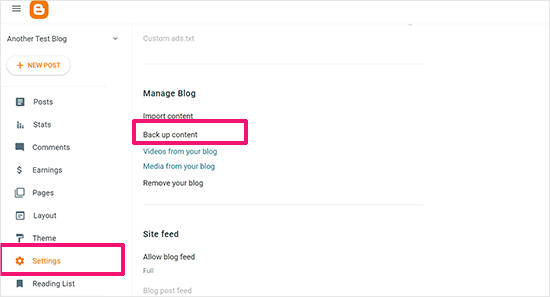
Daraufhin erscheint ein Popup-Fenster, in dem angezeigt wird, was genau in der Blogger-Sicherung enthalten ist.
Um fortzufahren, müssen Sie auf die Schaltfläche “Herunterladen” klicken.

Der Inhalt Ihres Blogger-Blogs wird in einer XML-Datei auf Ihren Computer heruntergeladen.
Sobald der Download abgeschlossen ist, können Sie Ihre Blogger-Inhalte in Ihre WordPress-Website importieren.
Schritt 2: Blogger in WordPress importieren
Um mit dem Import Ihrer Blogger-Site in WordPress zu beginnen, melden Sie sich in Ihrem WordPress-Administrationsbereich an und besuchen Sie Tools ” Importieren.
Klicken Sie auf der Import-Seite auf den Link “Jetzt installieren” unter Blogger.

WordPress wird nun das Blogger-Importer-Plugin für Sie herunterladen und installieren.
Sobald die Installation abgeschlossen ist, müssen Sie auf den Link “Importer ausführen” klicken, um fortzufahren.

WordPress wird Sie auf dem Bildschirm Blogger importieren auffordern, die XML-Datei hochzuladen. Dies ist die Datei, die Sie in Schritt 1 heruntergeladen haben.
Klicken Sie einfach auf die Schaltfläche “Datei auswählen” und laden Sie die XML-Datei hoch, die Sie zuvor heruntergeladen haben.
Klicken Sie anschließend auf die Schaltfläche “Datei hochladen und importieren”, um fortzufahren.
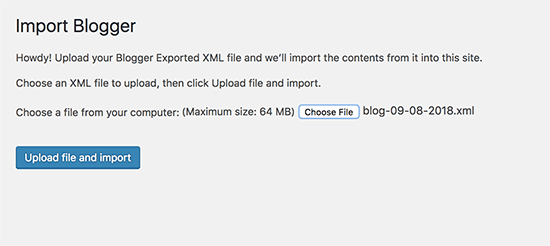
WordPress wird nun die Importdatei hochladen. Wenn Ihre Importdatei zu groß ist, wird möglicherweise eine Fehlermeldung angezeigt.
In diesem Fall müssen Sie die Höchstgrenze für den Datei-Upload erhöhen. Wenn Ihre Datei klein ist, werden Sie keine Fehler sehen.
Als Nächstes werden Sie aufgefordert, Beiträge einem Autor zuzuweisen. Wenn Sie mehrere Autoren in Ihrem Blogger-Blog haben, können Sie für jeden Autor ein neues Benutzerkonto erstellen. Sie können diese Beiträge auch bestehenden Autoren auf Ihrer WordPress-Website zuweisen.

Nachdem Sie Ihre Auswahl getroffen haben, klicken Sie auf die Schaltfläche “Senden”, um fortzufahren.
WordPress importiert alle Inhalte aus der Blogger-Exportdatei in Ihre WordPress-Website. Sie können den Inhalt auf der Seite Beiträge ” Alle Beiträge einsehen.

Schritt 3: Permalinks einrichten
Permalinks ist der Begriff für die URL-Struktur der einzelnen Seiten. WordPress verfügt über eine Funktion, mit der Sie eine SEO-freundliche URL-Struktur einrichten können.
Da Sie Inhalte von Blogger importieren, muss Ihre URL-Struktur der URL-Struktur Ihrer alten Blogger-Site so nahe wie möglich kommen.
Um Permalinks zu setzen, müssen Sie in Ihrem WordPress-Dashboard zu Einstellungen ” Permalinks gehen und die Option “Benutzerdefinierte Struktur” wählen.
Danach müssen Sie den folgenden Text in das Feld neben dem Feld für die benutzerdefinierte Struktur eingeben:
1 | /%year%/%monthnum%/%postname%.html |
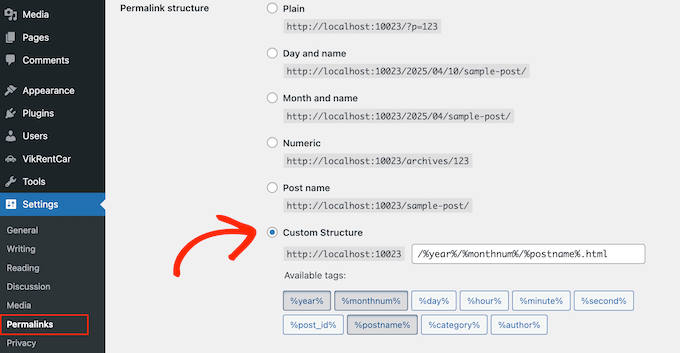
Mit dieser Permalink-Struktur ähneln die URLs Ihrer Blogposts den URLs in Ihrem alten Blogger-Blog.
Es kann jedoch vorkommen, dass die URL Ihres Blogeintrags, in WordPress auch als Slug bezeichnet, nicht mit den von Blogger verwendeten Slugs übereinstimmt.
Um dies zu beheben, müssen Sie ein kleines Codeschnipsel erstellen und ausführen.
Wir empfehlen, diesen PHP-Code mit dem WPCode-Plugin hinzuzufügen. Das ist der sicherste Weg, um benutzerdefinierten Code zu Ihrer WordPress-Website hinzuzufügen. Weitere Einzelheiten finden Sie in unserer Anleitung zum Kopieren und Einfügen von Codefragmenten in WordPress.
1 2 3 4 5 6 7 8 9 10 11 12 13 14 | add_action( 'init', 'wpb_update_slug' );function wpb_update_slug() {global $wpdb;$result = $wpdb->get_results("SELECT post_id, meta_value FROM $wpdb->postmeta WHERE meta_key = 'blogger_permalink' ");$wpdb->print_error();foreach ($result as $row){$slug = explode("/",$row->meta_value);$slug = explode(".",$slug[3]);$wpdb->query("UPDATE $wpdb->posts SET post_name ='$slug[0]' WHERE ID = '$row->post_id' ");}echo "DONE";} |
Nachdem Sie den Code gespeichert haben, brauchen Sie nur eine beliebige Seite auf Ihrer WordPress Website zu besuchen, um dieses Skript auszulösen. Vergessen Sie nach der Ausführung des Skripts nicht, es zu deaktivieren oder aus Ihrer WPCode-Bibliothek zu löschen, da es nur einmal ausgeführt werden muss.
Schritt 4: Umleitungen von Blogger zu WordPress einrichten
Der wichtigste Schritt beim Umzug einer Website ist die Einrichtung einer korrekten Umleitung, damit Sie keinen bestehenden Traffic oder SEO-Rankings verlieren. Weitere Details finden Sie in unserer ultimativen WordPress SEO-Migrations-Checkliste.
⚠️ Wenn Ihr Blogger-Blog eine eigene individuelle Domain anstelle von blogspot.com hat, müssen Sie Ihre Domain-Nameserver möglicherweise auf Ihren Hosting-Anbieter verweisen. Für Anweisungen folgen Sie bitte unserer Anleitung, wie Sie eine individuelle Domain von Blogger zu WordPress wechseln.
Entscheidend bei der Weiterleitung ist, dass Ihre Nutzer auf der neuen Domain auf der gleichen Seite landen, die sie auf der alten Site aufgerufen haben.
Gleichzeitig müssen Sie dafür sorgen, dass die Suchmaschinen verstehen, dass Ihre Website an diesen neuen Ort verlegt wurde.
Dazu müssen Sie das Plugin für die Umleitung von Blogger zu WordPress installieren und aktivieren. Weitere Details finden Sie in unserer Schritt-für-Schritt-Anleitung zur Installation eines WordPress-Plugins.
Nach der Aktivierung müssen Sie die Seite Tools ” Blogger to WordPress Redirection besuchen und auf die Schaltfläche “Start Configuration” klicken.
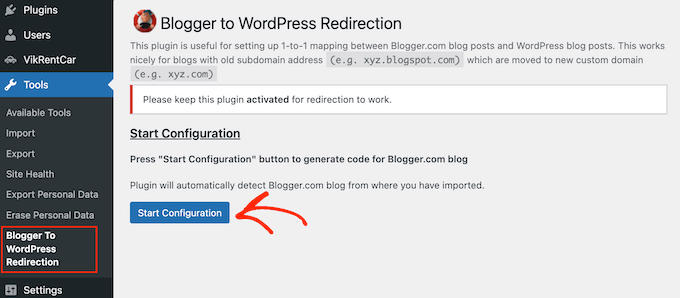
Das Plugin erkennt nun die URL Ihres Blogger-Blogs und zeigt Ihnen die Option an, einen Umleitungscode zu erhalten. Klicken Sie auf die Schaltfläche “Code abrufen” neben Ihrer Blogger-URL.
Es wird nun ein Codeschnipsel generiert, den Sie benötigen, um Benutzer von Ihrem alten Blogger-Blog auf Ihre neue WordPress-Website umzuleiten.
Als Nächstes müssen Sie sich in Ihrem Blogger-Dashboard anmelden und die Seite “Themen” aufrufen. Klicken Sie auf den Dropdown-Pfeil auf der Schaltfläche “Anpassen” neben Ihrem Thema, und wählen Sie dann die Option “HTML bearbeiten”.
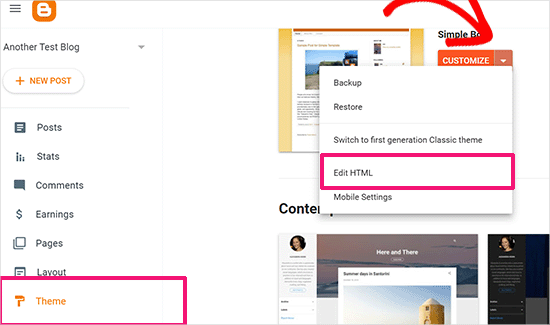
Blogger zeigt nun den benutzerdefinierten HTML-Code für Ihre Themenvorlage an. Wenn Sie Anpassungen an Ihrem Blogger-Theme vorgenommen haben, sollten Sie den Code kopieren und auf Ihrem Computer als Backup speichern.
Andernfalls können Sie einfach alles löschen. Kopieren Sie anschließend den vom Plugin angezeigten Code auf Ihrer WordPress-Website und fügen Sie ihn in den Editor Ihres Blogger-Themas ein.
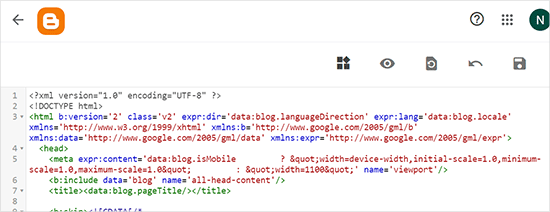
Vergessen Sie nicht, auf die Schaltfläche “Thema speichern” zu klicken, um Ihre Änderungen zu speichern.
Als Nächstes müssen wir Umleitungen für mobile Benutzer einrichten.
Gehen Sie im Dashboard Ihres Blogger-Blogs zurück zur Seite “Themen”. Diesmal müssen Sie auf die Zahnrad-Schaltfläche unterhalb der mobilen Vorschau Ihres Blogs klicken.

Daraufhin wird ein Popup-Fenster angezeigt, in dem Sie die Option “Nein. Desktop-Thema auf mobilen Geräten anzeigen” auswählen müssen.
Klicken Sie dann auf die Schaltfläche “Speichern”.
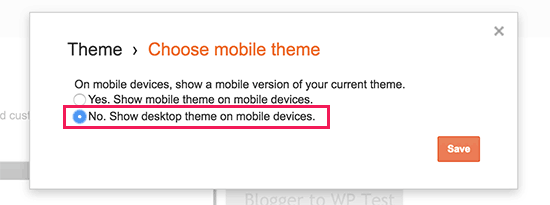
Das war’s. Ihr Blogger-Blog leitet nun alle Besucher Ihres Blogs auf Ihr neues WordPress-Blog um.
Alternativ können Sie auch All in One SEO (AIOSEO) verwenden, um Beiträge und Seiten von Blogger zu WordPress umzuleiten. Das Plugin bietet eine leistungsstarke Funktion für den Weiterleitungsmanager, mit der Sie vollständige Weiterleitungen zu Ihrer neuen Website einrichten können.

Außerdem können Sie die Verfolgung von 404-Fehlern aktivieren und alle defekten Links aufspüren, die bei der Umstellung Ihrer Website auf WordPress auftreten können. Dadurch wird die Benutzerfreundlichkeit verbessert, und Sie verlieren keine Keyword-Rankings.
Wir nutzen AIOSEO, um alle unsere WPBeginner Seiten und Beiträge zu verwalten – und ganz ehrlich? Wir sind von den Ergebnissen überwältigt. Deshalb ist es unsere beste Empfehlung für Sie alle.
Wenn Sie mehr über unsere Erfahrungen erfahren möchten, lesen Sie unsere ausführliche Rezension über AIOSEO.
Schritt 5: Verschieben anderer Inhalte von Blogger zu WordPress
In diesem Schritt werden wir die restlichen Inhalte aus dem alten Blog auf Blogger in Ihren neuen WordPress-Blog verschieben. Dies kann je nach den Einstellungen/Inhalten Ihres Blogs etwas manuelle Arbeit erfordern.
1. Verschieben von Seiten von Blogger zu WordPress
Das Blogger-Import-Tool von WordPress importiert nur Blogger-Beiträge und ignoriert Seiten.
Um Ihre Seiten in WordPress zu übertragen, müssen Sie jede Seite in Ihrem Blogger-Blog bearbeiten, ihren Inhalt kopieren und dann manuell eine Seite in WordPress erstellen.
Um mehr über Seiten zu erfahren, lesen Sie unseren Artikel über den Unterschied zwischen Posts und Seiten in WordPress.
Nun werden Sie auf ein weiteres Problem stoßen. Die Blogger-Seiten haben URLs, die wie folgt aussehen:
http://example.blogspot.com/p/about-us.html
Die URL Ihrer WordPress-Seite sieht dann so aus:
http://example.com/about-us
Um dies zu beheben, müssen Sie das All in One SEO (AIOSEO) Plugin verwenden. Eine Anleitung dazu finden Sie in unserem Leitfaden für Einsteiger zum Erstellen von Weiterleitungen in WordPress.
2. Widgets
Wie Blogger verwenden auch einige WordPress-Themes Widgets, um Inhalte in die Seitenleiste Ihres Blogs einzufügen.
Um Widgets hinzuzufügen, müssen Sie die Seite Erscheinungsbild ” Widgets in Ihrem WordPress-Dashboard aufrufen und Widgets einfach per Drag & Drop in die Seitenleisten ziehen. Ausführliche Anweisungen finden Sie in unserem Leitfaden zum Hinzufügen und Verwenden von Widgets in WordPress.
Wenn Sie ein bestimmtes Widget suchen, das nicht standardmäßig in WordPress enthalten ist, dann benötigen Sie wahrscheinlich ein WordPress-Plugin. Sie können WPBeginners beste WordPress-Plugin-Kategorie durchsuchen, um die gewünschte Funktionalität zu finden.
3. RSS-Feeds
Suchmaschinen und Nutzer, die Ihre Blog-Beiträge über RSS-Feeds abonnieren, können Ihr Blog weiterhin finden. Sie werden jedoch keine neuen Inhalte erhalten.
Um dies zu beheben, besuchen Sie die Seite Einstellungen in Ihrem Blogger-Konto. Scrollen Sie dann nach unten zum Abschnitt “Site-Feed” und klicken Sie auf “Post-Feed-Redirect-URL”.

Daraufhin wird ein Popup-Fenster angezeigt, in das Sie die URL des RSS-Feeds Ihrer WordPress-Website eingeben müssen.
Die URL Ihres WordPress-Feeds sieht dann so aus:
http://example.com/feed
Vergessen Sie nicht, example.com durch Ihren eigenen Domänennamen zu ersetzen.
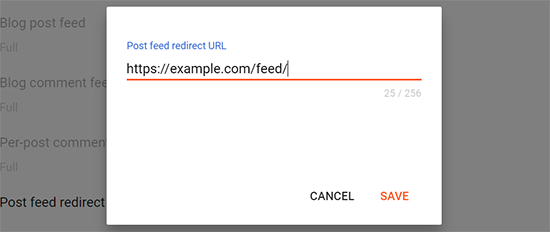
Klicken Sie auf die Schaltfläche “Speichern”, um die URL hinzuzufügen und Ihre Einstellungen zu speichern.
Schritt 6. Was Sie nach der Migration von Blogger zu WordPress tun sollten
Nachdem Sie Ihren Blogger-Blog nun erfolgreich nach WordPress verschoben haben, wollen wir uns ansehen, was Sie noch tun können, um Ihren Blog zu verbessern.
Wir haben eine Checkliste mit den wichtigsten Dingen erstellt, die Sie nach der Installation von WordPress erledigen müssen.
WordPress ist recht einfach zu bedienen. Dennoch werden Sie gelegentlich neue Dinge entdecken, bei denen Sie vielleicht Hilfe benötigen. An dieser Stelle kommt WPBeginner ins Spiel.
WPBeginner ist die größte kostenlose WordPress-Ressourcen-Website der Welt. Wir veröffentlichen regelmäßig Tutorials und Anleitungen, die speziell für Blogger und kleine Unternehmen geschrieben wurden.
Hier sind einige der nützlichen Ressourcen, die Sie auf WPBeginner finden werden (alle sind kostenlos):
- WPBeginner Blog – Der zentrale Ort für alle unsere WordPress-Tutorials und -Anleitungen.
- WPBeginner Dictionary – Unser WordPress-Glossar ist der beste Ort, um sich mit dem WordPress-Jargon vertraut zu machen
- WPBeginner Videos – Neue WordPress-Nutzer können mit diesen Schritt-für-Schritt-Videos beginnen, WordPress zu beherrschen.
- WPBeginner auf YouTube – Brauchen Sie mehr Videoanleitungen? Abonnieren Sie unseren YouTube-Kanal mit mehr als 291.000 Abonnenten und über 50 Millionen Aufrufen.
- WPBeginner Blueprint – Sehen Sie sich die Plugins, Tools und Dienstleistungen an, die wir auf WPBeginner verwenden.
- WPBeginner Deals – Exklusive Rabatte auf WordPress Produkte und Dienstleistungen für WPBeginner Nutzer.
Video-Anleitung
Wir hoffen, dass dieser Artikel Ihnen geholfen hat, von Blogger zu WordPress zu wechseln, ohne Ihre Google-Suchergebnisse zu beeinträchtigen. Vielleicht interessiert Sie auch unser Leitfaden, welchen WordPress-Plan Sie verwenden sollten, oder die häufigsten WordPress-Mythen, die entlarvt wurden.
Wenn Ihnen dieser Artikel gefallen hat, dann abonnieren Sie bitte unseren YouTube-Kanal für WordPress-Videotutorials. Sie können uns auch auf Twitter und Facebook finden.





Bf
I have a related question. I’m starting a new blog and I’m using the Example.wordpress.com url for now. If I get more hits, then I’ll buy the domain example.com… if I do that, will I lose my rankings? because example.worpdress.com/example1 will now be example.com/example1
?
I hope this makes sense and thanks for your help!
WPBeginner Support
Please see our guide on the difference between self hosted WordPress.org vs free WordPress.com blog.
Admin
Rubina Ladjanszky
Thank you very much for this detailed description. I could manage to do this with my blogger site, now it is functioning on word press. However, I have a question. What happens to my Google Search Console account? I mean as the posts from the old blog are redirected to the new site on wordpress, how will this all show on Search Console? Do I have to add my new domain to search console as a new site was created or just should I stick to monitoring the old blog or both? I hope you see my point.
rose
hi guys,
Ive been importing my blog into my wp website,
however, the message said…
Sorry, there has been an error.
File is empty. Please upload something more substantial. This error could also be caused by uploads being disabled in your php.ini or by post_max_size being defined as smaller than upload_max_filesize in php.ini.
what can i do to correct this?
hope all the help I can get please…
sincerely,
rose
WPBeginner Support
Hi Rose,
Try uploading an image file by visiting Media » Add New page. If you can upload an image file, then this could mean something else is wrong. However, if you cannot upload an image file, then please see our guide on how to increase the maximum file upload size in WordPress.
Admin
rose
Hi wpbeginner support,
^_^ thank you for your response and help!
I finished transferring my blogger posts in wp website via blogger import extended plug in (basically all my posts was transferred to my wordpress, is it suppose to be that way?)
should my next step is to redirect my readers from blogger to wordpress through plugin 301 (redirection)?
thanks so much for your help ^_^
sincerely,
rose!
daniela
I am having issues to the redirect from one to exact post on my wordpress. Does anyone have any suggestions. Really need the help
Suzana
Hy,
i have set redirections from blogspot to my new website on wordpress and everything went very well. All my posts are redirected.
There is only one thing and i can not figure out what have i done wrong. After a week, google indexed new titles which are on wordpress, but not links of new domain. I have check google temporary memory and it looks that google thinks that my new wordpress site is on blogspot link. I have checked server header response and it gives me 200 response for blogspot link and not 301 response. When i click on blogspot link, it redirects me on new domain but header response is 200. Can you help me?
Gautam Nagraj
Hello WPBeginner Team,
Excellent write-up, thanks for this article
One question I want to ask you and that is
Is it beneficial to migrate from blogger to WordPress in the terms of AdSense or Affiliates
I mean can we boost our adsense earnings by this migration?
The role of WordPress in adsense earnings?
WPBeginner Support
Hi Gautam,
We are not sure about Adsense earnings. However, having a self-hosted blog allows you the flexibility to grow your blog with limitless possibilities. You can diversify your blog’s revenue sources and will be able to explore many other ways to monetize your content.
Admin
Paras Sidhu
Hi there, I have a question about website redirection. I moved from Blogger Custom Domain to WordPress.
I put that code in functions.php file but links weren’t redirecting. I had changed permalink too. The reason maybe is Blogger shorts the post name like if a post name is “A B C D E F G H”, blogger changes to “A B C D E” in url however WordPress doesn’t. So is there any solution? Am I doing wrong anything?
So I am using Smart 404 for now which redirects most of wrong urls to correct one.
Thank you very much for your help.
Tarun Singh
I have got these warnings after running importer. Can somebody please help me?
reset() expects parameter 1 to be array, boolean given in /srv/users/serverpilot/apps/imtswp/public/wp-content/plugins/blogger-importer/blogger-importer.php on line 700
DAVID NWACHUKWU
Is the file your importing more than 2MB? I think that’s a potential cause of the error problem.
Nicole
Hi, I transfered my blog from Blogspot to wordpress 4 years ago. How long do I need to keep the redirection plugin in place you think?
I’m trying to cut back on plugins you see.
Jessica
We used this article to switch from blogger to WP over a year ago. Everything went well, but now I’m cleaning up plugins. Do I need to keep the Blogger 301 Redirect plugin active and installed? Or can I delete it now that everything’s done?
WPBeginner Support
Check your Google Analytics reports to see if you are still getting visitors from blogger. If you are then, there is no harm in keeping the plugin activated. If there are not many users coming from blogger anymore, then you can safely turn it off.
Admin
Cecilia
Can you PLEASE clarify…are we supposed to also install a Blogger 301 Redirect Plugin or if we simply follow the indicated steps without the plugin everything will work?? Jessica what did you do?
Benneth
Hi @wpbeginner support, you have written a wonderful article. I own a job portal site on blogger and am already using a custom domain name on my site. Please is there a way out for me? Considering that am already using a custom domain name registered with godaddy. Please i need your assistance thanks
WPBeginner Support
Hi Benneth,
Yes you can point your custom domain to your self hosted WordPress site.
Admin
Gary Gramp
I am regular reader, how are you everybody? This post posted at this web page is really good.
Shanda
I recently made the switch from blogger to WordPress. Thanks to your tutorial, it appears to have gone well! I did notice recently though that the redirect does not work while mobile. While on my desktop if I click a Pinterest link that I had previously created, it will redirect to my new WordPress site, but once mobile, it is still taking people to my blogger site. Any tips for fixing this? Thanks!
Cathis
Thanks for the guide – works perfectly!
Nikhil Kapoor
My google adsense account is active on blogspot. Do i have to apply for adsense again or it can also be exported to wordpress????
WPBeginner Support
Hi Nikhil,
You can use the same Adsense account on as many websites as you want.
Admin
Narendra Singh
When I shift my blog to wordpress it done nicely but what I notice that on my each blog there is a image first and then blog is starting and when i am editing this post it is not showing the images in the edit mode.
Please suggest
CARLA
HELLO I am stuck I keep getting this error
I keep getting this error
Have you ever heard of this?
Invalid argument supplied for foreach() in /home/welcomet1/public_html/wp-content/plugins/blogger-importer/blogger-importer.php on line 227
Kira Langolf
Thanks! Your guide was so easy to complete!
ravi
missing export blog option for the latest version. now how can i migrate blogger posts to wordpress
Jamie Foster
Great instructions. Thanks so much!
One problem. My posts redirected like a champ. However, a page did not.
thoughts?
stephanie
Hi! I just recently switched from blogger to wordpress and truly appreciate your site for all its helpful information. I’ve used it quite a bit! I’m at this point now of setting the redirects. I did all of the steps above but when you click on an old link (from blogger), it takes you to my “new” WP site but it’s a 404 page. Not a 301. Why is it not working and how come it doesn’t take them directly to the correct post? I thought that was what this tut was for -no? Any help is greatly appreciated. Thanks.
Sumit Kumar
I switch from wordpress to blogger but it was terrible for me. I want again to switch on blogger. Will you please help me to switching from wordpress to blogger with all data. Also please switch domain name from wordpress to blogger.
Thans
Raihan
This post have good information and a list of all the activity with good explanation. I started a blog years ago and stopped after maybe a year. I purchased a domain and I still own it. Now I’m ready to start blogging again and have decided to go with WordPress instead. However, the entire design is crap.
Raihan
I’m heavily considering making the switch to WordPress. However, I already have a custom domain name purchased and in use.
I figured it out with the help of another tutorial.
chittara
Thanks for the wonderful post.it helped me a lot.
but i am facing problem in finding” functions.php” in my wordpress personal plan. Where it will be?
Ewan
Hi, after following the steps redirection is working properly but I have the following notice appearing at the top of the page:
Notice: Undefined index: blogger in /home/sites/mywebsite.co.uk/public_html/wp-content/themes/mytheme/functions.php on line 417
Line 417 is:
$blogger = $wp_query->query_vars[‘blogger’];
Any advice on how to get rid of this message?
Reg
Hi, I tried pasting the codes but I get this error whenever i try to put it under functions:
Notice: Undefined index: blogger in /home2/username/public_html/wp-content/themes/tracks/functions.php on line 12
Any idea?
Foxx
Hello~
I have the same issue.
Can someone fix this problem?
Brona
This has been very helpful in understanding what I need to do, but sadly, it looks like WP have removed the permalink tab in settings.
I’ve got this far
but unless I can take all my links with me, I wont be changing my other blogs to wp. I need/want all the links.
Is there some other way to find the permalink option?
Blogger also allowed me to easily change code when I needed to…where is the tab to do this on wp?
Many thanks Brona
WPBeginner Support
Please see our guide on the difference between self hosted WordPress.org vs free WordPress.com blog.
Admin
Meric
Hi,
I follow the all steps you mention above. It’s great explanation. I have just one problem regarding to my indexed pages on google. If you use mobile web then link is
but if you use from desktop (which is works)
How I can canonicalize first one to second one ?
Regards
Anjerico
Hi WPBeginner team. I’m trying to migrate from blogger to WordPress. I already looked at the description of the blogger importer.And it says there that it cannot import the theme/template from blogger to WordPress. I know it’s kind of silly to ask, but is there a way that this limitation could be overcome? Such that when I’m migrating from blogger to WordPress, the template is also migrated?
Thank you.
WPBeginner Support
Hey Anjerico,
Unfortunately, this will not be possible. Blogger and WordPress use totally different templating systems. However, if you know enough HTML and CSS then you can try to replicate the looks of your old blogger website in a WordPress theme. You can also hire professionals who can transform a WordPress theme to look similar to your old blogger blog.
Admin
Anjerico
I see.
Thank you for answering my question.
Tamás
Hello,
It’s a great video. My problem is only that I changed the URL structure from 2015/05/post-name to
post-name.
Is there any sollution for this case?
Tamás
Any suggestion?
Jaga
Hi WPBeginner team , I have migrated from Blogger to WP, One week later, I was shocked to find it is redirected to some other website. I found it in Google in sight speed test.
anonymous
can move from blogger to WordPress using WordPress sub-domain ?
Munna Hossain
Blogger is one of the best blogging platforms. But sooner or later you need to migrate from blogger to WordPress. If you want to build your authority on your blog then WordPress is the best choice. But I think blogger is better for the newbies who just starting. Your article will be helpful for those who want to shift from blogger to WordPress. Thanks for your article.
Anupriya
Help me!!!!! I successfully migrated from blogger to wordpress, but i am facing problem in finding” functions.php” Where is it????
yvonne
Hi,
Thank you for the article it helped me to complete my migration. However, all of my images didn’t come over and my pages didn’t come over. I’ve tried multiple plugins for my images including what you suggeted and have come to the conclusion I will just have to insert them manually. But, I really do need my pages and I didn’t see anything in your article referencing pages. Also, Any ideas since the Blogger Importer plugin specifically says it does not import pages?
Dora
Hi, thank you for the great video!
I have the same issue. Post texts are imported successfully, but not the photos.
Do you have any suggestion for that?
Janis
Well, the redirection doesnt work
Dont know if the problem is in the blogger code or WP code.
Shakil Ilyas
i am facing: my file size is 14.5 MB
Import Blogger
Sorry, there has been an error.
File is empty. Please upload something more substantial. This error could also be caused by uploads being disabled in your php.ini or by post_max_size being defined as smaller than upload_max_filesize in php.ini.
Shakil Ilyas
i cant save my template in html the code is incorrect show in ..
how i attached file .. i want to show you
Dawn
I successfully moved my Blogger site to WordPress, redirect, everything is working! Except that some posts point successfully to their WordPress counterpart, some just redirect to my main page! I have no idea why some worked and some didn’t…is there a way to fix this?
Kimberly Dsouza
I’d like to know the same. In my case most of the original links redirect to my main page and not to the actual post!
Have you figured it out?
Yvonne
I started a blog years ago and stopped after maybe a year. I purchased a domain and I still own it. Now I’m ready to start blogging again and have decided to go with WordPress instead. However, the entire design is crap. Therefore, my question to you is, when I migrate from Blogger to WordPress using your guide won’t that same design come over? If so, does that mean my initial step after getting a web host be to pick a them and install to WordPress or do I do that after I move from Blogger to WordPress? I want to keep the post. But, definitely not the design! I love this article and found it incredibly informative.
Mohini
Thanks for this detailed article. Helped me to rectify some issues smoothly. Still, I couldn’t paste redirection code snippet to WordPress. Can you please help me?
I am getting this warning:
“Warning: Cannot modify header information – headers already sent by (output started at /home/username/public_html/wp-content/plugins/mysitename-plugin/mysitename-plugin.php:44) in /home/username/public_html/wp-content/plugins/wpclef/includes/lib/wp-session/class-wp-session.php on line 130”
I removed the code seeing error still got the same warning. Site plug in is deactivated now.
I don’t have clef activated yet.
Thanks for all the help and extremely helpful site for WP beginners.
Ansley
I’m heavily considering making the switch to WordPress. However, I already have a custom domain name purchased and in use. Do I just skip the first section about purchasing a self hosted domain, or do I have to switch domain hosts? My current domain name is through easyDNS. (PS they kind of suck – not user friendly at all!)
Thanks!
deni
why images can’t be export too ?
all image in our blogpost not included when i export to wordpress? just text without images.
Angel
Much appreciate for this detailed tutorial. I’ve redirected all my articles to my new wordpress site and it looks awesome!
Thanks!!
Karo
Hello Angel,
I’m glad to hear the steps worked for you. At my end it seems I am getting something wrong. I followed the steps and imported my blog. And when I click on View Blog on Blogger it goes to my new WordPress blog which is good. However when I click on a post from Blogger it gives me a ‘page not found’ on the WordPress blog. I can’t seem to figure out what I am missing. Shouldn’t the post be redirecting to the one on the WordPress blog? If you can guess what’s causing this I’ll appreciate it.
WPBeginner Support
Try updating permalinks in WordPress. Simply go to Settings > Permalink page and click on the save changes button without making any changes.
Admin
Karo
Thanks. But everything is working fine now. I figured it out with the help of another tutorial.
Danielle
I did everything you said, step by step and I have no photos in my posts anymore? Help!!
Ewan
Hi,
Thanks for the very helpful guide. I’m wondering if there is a way to do this while maintaining a more SEO friendly URL structure within wordpress. I want my blogspot posts to redirect properly, but I’d like them to redirect to example.com/my-blog-post rather than example.com/2016/09/my-blog-post. I think perhaps a change could be made to the PHP code added to functions.php to make this work but I’m not sure how.
Any thoughts?
Jen at Tie Dye Diva
Thank you! I can’t say how many times I came back to this page in the last week and followed it step by step, very clear instructions! I noticed that the redirect doesn’t work from my iphone though it works beautifully from laptop – mobile still goes to my blogspot. Is there something more I need to do to get it to work on mobile?
WPBeginner Support
In your blogger dashboard visit the Template page for your blog.
If you have switched to the classic template then you will see a button to Upgrade template. Click on this button and Blogspot will start using the new template format. It will show you a preview of how your site will look on Desktop and how it will look on mobile.
Under the mobile column, click on the gear icon. This will bring up a popup. Select ‘No. Show desktop template on mobile devices’ option and then click on the save button.
Now start following the instructions from Step 4 in this article.
Admin
Jen at Tie Dye Diva
You’re the best!
Arjun
What about Google search links of my website. Will they land exactly where they are supposed to reach. Won’t users get 404 error.
And what if blogger url structure doesn’t match in wordpress. Since I have manually configured the urls in my blogger blog.
Justine Putterman
This saved my life!!! I was so lost trying to figure out how to move from blogger to wordpress and this tutorial made everything so easy! I followed along with the video step by step. Thank you so much!!
WPBeginner Support
We are glad you found it helpful
Don’t forget to follow us on Twitter for useful WordPress tips and tricks.
Admin
Sid Balachandran
I’m clutching at straws here, so hoping that you can help.
The Blogger xml file was about 42Mb – so I had BlueHost increase it to 64Mb. But ever since that happened, when I run the Blogger Import tool, the upload goes to 100% alright. However, the next step – where you get to choose the authors – that never appears. All I get is the heading that says ‘Import Blogger’. I’ve tried on different browsers, different laptops – no go.
And I can’t move forward. Spoke to Bluehost, who said they’ll look into it, but no go since that.
I tried a smaller test xml file form an old blogger id that I had, and that uploads fine. So I reckon it has something to do with the time out or something. But of course, I’m not sure.
Do you have any suggestions?
Would really appreciate some help, if you could spare the time.
WPBeginner Support
BlueHost increased your maximum file upload size. You also need to increase php memory limit allowing php to run processes for longer duration.
Admin